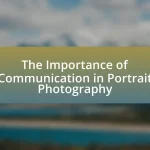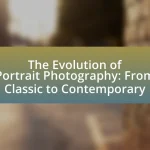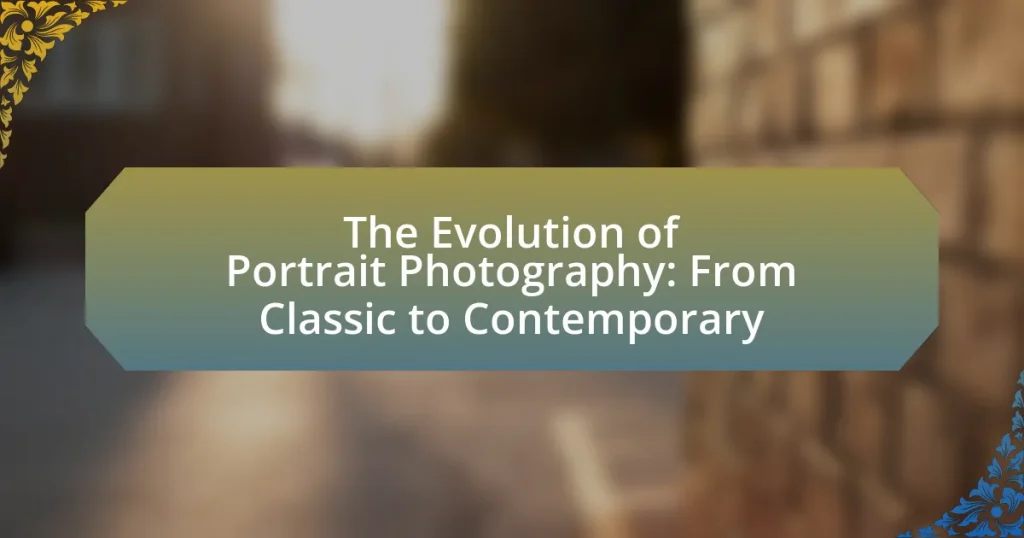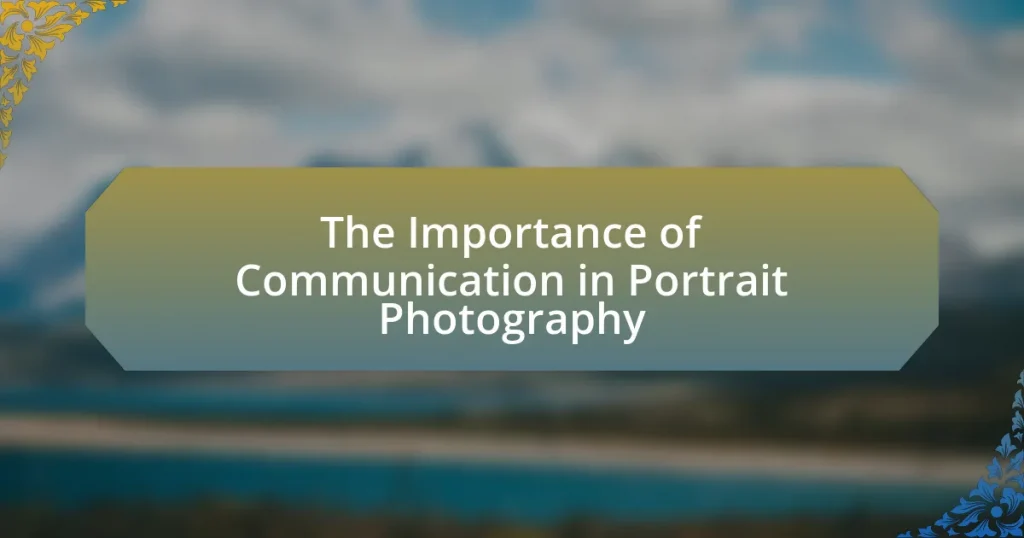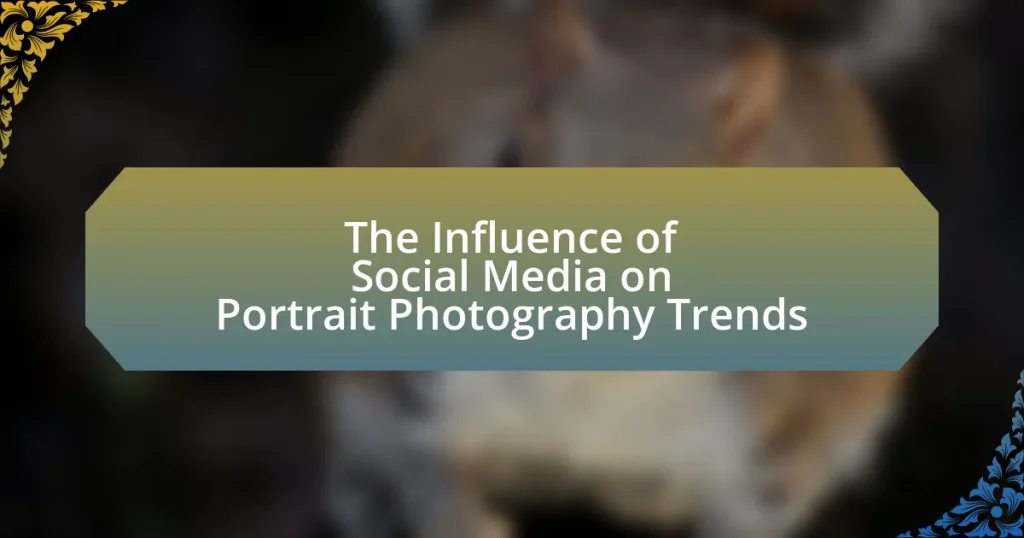The article examines the evolution of portrait photography, tracing its development from the early 19th century with the introduction of daguerreotypes to the contemporary digital age. It highlights key milestones such as the advent of roll film, color photography, and the impact of social media on accessibility and style. The discussion includes the defining characteristics of classic versus contemporary portrait photography, the influence of cultural contexts, and the role of technological advancements in shaping artistic expression. Additionally, it addresses current trends, essential skills for photographers, and best practices in today’s portrait photography landscape.
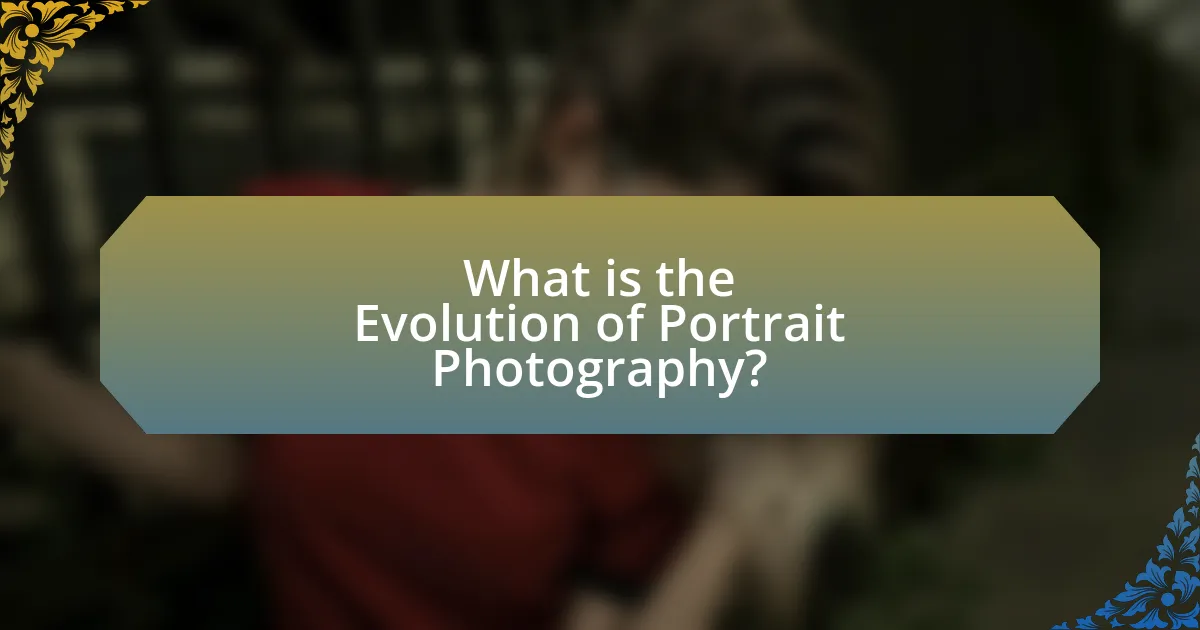
What is the Evolution of Portrait Photography?
The evolution of portrait photography began in the early 19th century with the advent of daguerreotypes, which allowed for detailed, permanent images of subjects. This innovation marked a significant shift from painted portraits, making photography more accessible and affordable. By the late 1800s, advancements in camera technology and film development led to the introduction of portrait studios, where professional photographers could capture images in controlled environments. The 20th century saw the rise of various styles, including candid photography and environmental portraits, reflecting the subject’s personality and surroundings. The digital revolution in the late 20th and early 21st centuries further transformed portrait photography, enabling instant capture and editing, as well as the proliferation of social media platforms that democratized image sharing. This progression illustrates how portrait photography has continuously adapted to technological advancements and cultural shifts, maintaining its relevance in contemporary society.
How has portrait photography changed over time?
Portrait photography has evolved significantly from the early days of painted portraits to modern digital photography. Initially, portraiture was a luxury reserved for the wealthy, often involving lengthy sessions with artists who captured subjects in oil or watercolor. The invention of the daguerreotype in the 1830s marked a pivotal shift, making photography more accessible and allowing for quicker, more realistic representations of individuals.
As technology progressed, the introduction of roll film in the late 19th century further democratized portrait photography, enabling amateur photographers to capture images easily. The 20th century saw the rise of various styles, including candid photography and environmental portraits, reflecting changes in societal norms and artistic expression.
Today, digital photography and editing software have transformed portrait photography, allowing for instant results and extensive manipulation, which has led to diverse styles ranging from hyper-realistic to abstract. The shift from film to digital has also made portrait photography more accessible to the general public, with smartphones enabling anyone to take and share portraits instantly.
What were the key milestones in the history of portrait photography?
The key milestones in the history of portrait photography include the invention of the daguerreotype in 1839, which was the first practical method of capturing images, allowing for detailed portraits. The introduction of the tintype in the 1850s made photography more accessible and affordable, further popularizing portrait photography. The development of roll film in the late 19th century enabled quicker and more spontaneous portrait sessions. The advent of color photography in the mid-20th century transformed portrait styles, allowing for more vibrant and realistic representations. Finally, the rise of digital photography in the late 20th century revolutionized portrait photography by providing instant results and extensive editing capabilities. Each of these milestones significantly impacted the techniques and accessibility of portrait photography throughout history.
How did technological advancements influence portrait photography?
Technological advancements significantly influenced portrait photography by enhancing image quality, accessibility, and creative possibilities. The introduction of the daguerreotype in the 1830s allowed for detailed and permanent images, making portrait photography more popular among the public. The development of roll film in the late 19th century further democratized photography, enabling more people to capture portraits without the need for cumbersome equipment. Additionally, the advent of digital photography in the late 20th century revolutionized the field by allowing instant review and editing of images, which increased the versatility and creativity of portrait photographers. These advancements collectively transformed portrait photography from a specialized art form into a widely practiced medium, reflecting societal changes and technological progress.
What are the defining characteristics of classic portrait photography?
Classic portrait photography is characterized by its emphasis on the subject’s face, expression, and personality, often utilizing controlled lighting and composition to highlight these features. This style typically employs a shallow depth of field to create a soft background, drawing attention to the subject. Additionally, classic portraits often feature formal poses and attire, reflecting the cultural and social norms of the time. Historical examples, such as the works of photographers like Julia Margaret Cameron and Richard Avedon, demonstrate these characteristics through their focus on emotional depth and clarity in the subject’s portrayal.
What techniques were commonly used in classic portrait photography?
Classic portrait photography commonly utilized techniques such as controlled lighting, posed subjects, and the use of backdrops. Controlled lighting, often achieved through natural light or studio setups, was essential for highlighting the subject’s features and creating mood. Posed subjects were carefully arranged to convey personality and emotion, with attention to body language and facial expressions. Additionally, backdrops, ranging from simple fabrics to elaborate painted scenes, were employed to enhance the composition and context of the portrait. These techniques were foundational in establishing the aesthetic and emotional depth characteristic of classic portrait photography.
How did cultural contexts shape classic portrait photography styles?
Cultural contexts significantly shaped classic portrait photography styles by influencing the subjects, poses, and settings depicted in the images. For instance, during the Renaissance, the emphasis on humanism led to portraits that highlighted individualism and social status, often featuring subjects in elaborate clothing and settings that reflected their wealth and power. In contrast, Victorian-era portraiture focused on family and societal roles, with formal poses and props that conveyed moral values and social hierarchy. Additionally, cultural norms regarding gender and ethnicity dictated how subjects were portrayed, as seen in the use of specific attire and settings that aligned with societal expectations of the time. This interplay between cultural values and artistic expression is evident in the works of photographers like Julia Margaret Cameron, who captured the idealized femininity of her subjects, and the formal compositions of 19th-century portrait studios that catered to the middle class.
What are the main differences between classic and contemporary portrait photography?
Classic portrait photography emphasizes formal poses, traditional lighting, and often a controlled environment, while contemporary portrait photography embraces spontaneity, diverse styles, and innovative techniques. Classic portraits typically feature subjects in static positions with a focus on idealized beauty, often using soft lighting and backdrops that convey a sense of timelessness. In contrast, contemporary portraits frequently incorporate dynamic compositions, natural lighting, and candid moments, reflecting a more personal and authentic representation of the subject. This shift is evident in the use of digital technology and social media, which have democratized portrait photography, allowing for a broader range of expressions and styles.
How has the approach to subject matter evolved in portrait photography?
The approach to subject matter in portrait photography has evolved from formal, posed representations to more candid and diverse expressions of identity. Historically, portrait photography focused on capturing the subject’s social status and physical appearance, often emphasizing traditional attire and settings, as seen in the works of 19th-century photographers like Julia Margaret Cameron. In contrast, contemporary portrait photography embraces a broader range of subjects, including marginalized communities and personal narratives, reflecting societal changes and the influence of social media. This shift is evident in the work of photographers such as Annie Leibovitz and Tyler Mitchell, who prioritize authenticity and emotional connection over conventional aesthetics.
What role does digital technology play in contemporary portrait photography?
Digital technology plays a crucial role in contemporary portrait photography by enabling high-resolution imaging, advanced editing capabilities, and instant feedback during shoots. This technology allows photographers to capture intricate details and colors that were previously unattainable with film, enhancing the overall quality of portraits. For instance, digital cameras often feature sensors that can capture images with resolutions exceeding 50 megapixels, providing exceptional clarity. Additionally, software like Adobe Photoshop and Lightroom offers powerful tools for retouching and manipulating images, allowing for creative expression and correction of imperfections. The immediacy of digital photography also allows photographers to review images on-site, facilitating adjustments to lighting and composition in real-time, which significantly improves the final outcome of portrait sessions.
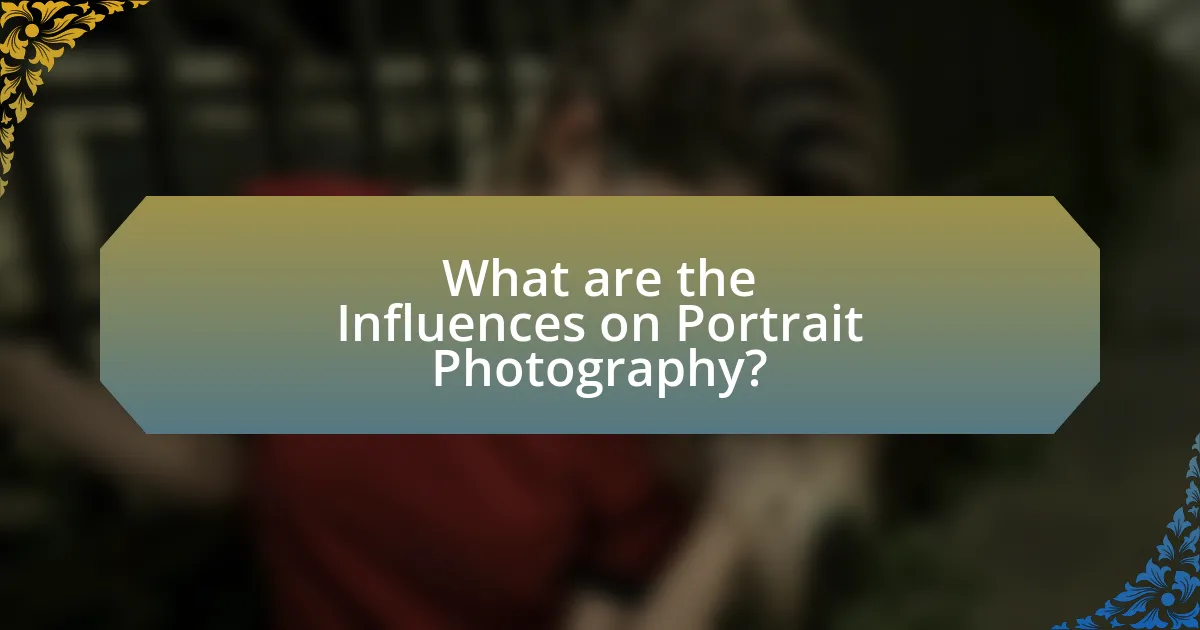
What are the Influences on Portrait Photography?
The influences on portrait photography include cultural, technological, and artistic factors. Cultural influences shape the subjects, styles, and contexts of portrait photography, reflecting societal values and norms. For instance, the Renaissance period emphasized humanism, leading to more lifelike representations in portraits. Technological advancements, such as the invention of the camera and digital editing software, have transformed how portraits are captured and processed, allowing for greater creativity and accessibility. Artistic movements, like Impressionism and Modernism, have also impacted portrait photography by introducing new techniques and perspectives, encouraging photographers to explore abstraction and emotional expression. These influences collectively contribute to the evolution of portrait photography from classic to contemporary styles.
How have social changes impacted portrait photography?
Social changes have significantly impacted portrait photography by shifting the focus from formal, staged representations to more candid and diverse expressions of identity. Historically, portrait photography primarily served the elite, capturing idealized images that reinforced social hierarchies. However, with the rise of social movements advocating for equality and representation, such as feminism and civil rights, portrait photography has evolved to include a broader spectrum of subjects, emphasizing authenticity and personal narratives. This shift is evidenced by the increasing popularity of informal portrait styles and the use of social media platforms, where individuals share their own stories and images, democratizing the art form and challenging traditional norms.
What movements or trends have shaped the evolution of portrait photography?
The evolution of portrait photography has been shaped by several key movements and trends, including the advent of realism, the influence of modernism, and the rise of digital technology. Realism in the 19th century emphasized capturing subjects in their true form, leading to more authentic representations. Modernism introduced abstraction and experimentation, allowing photographers to explore new perspectives and techniques. The digital revolution in the late 20th century transformed portrait photography by making it more accessible and enabling innovative editing and sharing methods, fundamentally changing how portraits are created and consumed. These movements collectively reflect the ongoing dialogue between artistic expression and technological advancement in portrait photography.
How do societal values reflect in portrait photography styles?
Societal values significantly influence portrait photography styles by shaping the subjects, themes, and aesthetics that photographers choose to represent. For instance, during the Victorian era, portrait photography emphasized social status and propriety, reflecting the values of modesty and family lineage prevalent at that time. In contrast, contemporary portrait photography often embraces diversity and individuality, showcasing a broader range of identities and experiences, which aligns with modern values of inclusivity and self-expression. This evolution is evident in the shift from rigid poses and formal attire in classic portraits to more candid and relaxed styles in contemporary works, highlighting changing societal norms around authenticity and personal narrative.
What role do artists and photographers play in the evolution of portrait photography?
Artists and photographers are pivotal in the evolution of portrait photography by shaping its aesthetic, techniques, and cultural significance. Throughout history, artists like Leonardo da Vinci and photographers such as Julia Margaret Cameron have influenced the portrayal of subjects, emphasizing emotional depth and individuality. For instance, the introduction of soft focus by Cameron in the 19th century transformed the perception of portraiture, moving away from rigid formalism to a more expressive style. Additionally, the advent of digital photography has allowed contemporary photographers to experiment with new forms and concepts, further expanding the boundaries of portrait photography. This ongoing dialogue between artistic vision and photographic innovation continues to redefine how identity and personality are captured in portraits.
Who are some influential portrait photographers throughout history?
Some influential portrait photographers throughout history include Richard Avedon, Annie Leibovitz, and Yousuf Karsh. Richard Avedon revolutionized fashion photography and portraiture with his stark, minimalist style, capturing the essence of his subjects in a way that emphasized their personality. Annie Leibovitz is renowned for her iconic celebrity portraits, often blending art and journalism, which has shaped modern visual culture. Yousuf Karsh is celebrated for his powerful portraits of notable figures, including Winston Churchill, which have become emblematic of his ability to convey character and emotion through photography. These photographers have significantly impacted the field, each contributing unique techniques and perspectives that continue to influence contemporary portrait photography.
How have individual styles contributed to the evolution of portrait photography?
Individual styles have significantly contributed to the evolution of portrait photography by introducing diverse techniques, perspectives, and emotional expressions that reflect cultural and societal changes. For instance, the transition from formal, posed portraits in the 19th century to more candid and expressive styles in the 20th century illustrates this evolution. Pioneers like Julia Margaret Cameron emphasized soft focus and artistic composition, while modern photographers such as Annie Leibovitz brought storytelling and personality into their work. These individual approaches not only shaped the aesthetic of portrait photography but also influenced how subjects are perceived, making the medium more relatable and dynamic. The incorporation of personal style has thus been a driving force in the ongoing transformation of portrait photography, allowing it to adapt to contemporary themes and technologies.
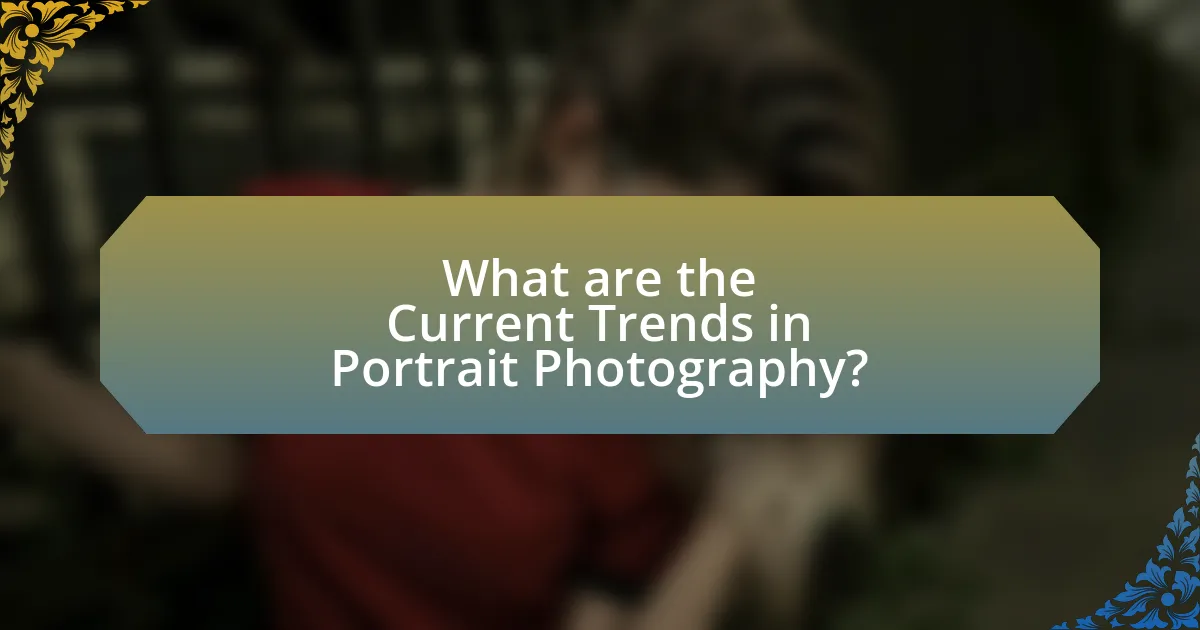
What are the Current Trends in Portrait Photography?
Current trends in portrait photography include the use of natural light, candid poses, and environmental settings. Photographers increasingly favor natural light to create soft, flattering images, moving away from harsh studio lighting. Candid poses capture genuine emotions and interactions, making portraits feel more authentic. Additionally, incorporating environmental elements allows for storytelling within the image, providing context and depth. According to a 2022 survey by the Professional Photographers of America, 68% of photographers reported a shift towards lifestyle and documentary-style portraits, reflecting these trends.
What contemporary techniques are popular in portrait photography today?
Contemporary techniques popular in portrait photography today include natural light usage, environmental portraits, and advanced post-processing methods. Natural light is favored for its ability to create soft, flattering images, while environmental portraits capture subjects in their personal or professional settings, adding context and storytelling elements. Advanced post-processing techniques, such as frequency separation and skin retouching, enhance image quality and allow for creative expression. These techniques reflect current trends emphasizing authenticity, context, and technical precision in portrait photography.
How do modern photographers utilize social media for portrait photography?
Modern photographers utilize social media to showcase their portrait photography, engage with audiences, and attract clients. By sharing high-quality images on platforms like Instagram and Facebook, photographers can reach a wider audience, as these platforms have millions of active users. Additionally, social media allows for real-time interaction with followers, enabling photographers to build a community and receive immediate feedback on their work. According to a survey by the Pew Research Center, 72% of adults use social media, making it a vital tool for marketing and networking in the photography industry. Furthermore, the use of hashtags and location tags enhances discoverability, allowing potential clients to find photographers based on specific styles or geographic areas.
What innovative styles are emerging in contemporary portrait photography?
Innovative styles emerging in contemporary portrait photography include environmental portraits, which capture subjects in their natural surroundings to convey their personality and lifestyle. Additionally, the use of mixed media, combining photography with digital art or traditional painting techniques, is gaining popularity, allowing for unique visual narratives. Another trend is the incorporation of artificial intelligence in editing and composition, enabling photographers to create surreal and imaginative portraits that challenge traditional aesthetics. These styles reflect a shift towards personalization and storytelling in portrait photography, aligning with contemporary cultural trends.
How can aspiring photographers adapt to the evolving landscape of portrait photography?
Aspiring photographers can adapt to the evolving landscape of portrait photography by embracing new technologies and trends, such as digital editing software and social media platforms for showcasing their work. The integration of advanced tools like Adobe Lightroom and Photoshop allows photographers to enhance their images creatively and efficiently, aligning with contemporary aesthetic preferences. Additionally, utilizing platforms like Instagram and TikTok enables photographers to reach wider audiences and engage with potential clients, reflecting the shift towards digital marketing in the photography industry. This adaptability is crucial as the demand for unique and personalized portraits continues to grow, driven by consumer preferences for authenticity and storytelling in visual content.
What skills are essential for success in contemporary portrait photography?
Essential skills for success in contemporary portrait photography include technical proficiency in camera operation, an understanding of lighting, and strong interpersonal communication abilities. Technical proficiency allows photographers to effectively manipulate settings such as aperture, shutter speed, and ISO to achieve desired effects. Mastery of lighting techniques, including natural and artificial light, is crucial for creating mood and depth in portraits. Additionally, strong interpersonal communication skills enable photographers to connect with subjects, making them comfortable and facilitating authentic expressions. These skills collectively enhance the quality and impact of portrait photography in a contemporary context.
What best practices should photographers follow in today’s portrait photography scene?
Photographers should prioritize natural lighting, effective communication, and post-processing techniques in today’s portrait photography scene. Natural lighting enhances the subject’s features and creates a more authentic atmosphere, as studies show that images taken in natural light are often perceived as more appealing. Effective communication with subjects fosters comfort and confidence, leading to more genuine expressions, which is crucial for capturing the essence of the individual. Additionally, post-processing techniques, such as color correction and retouching, are essential for achieving a polished final image, as they allow photographers to enhance the visual impact while maintaining the subject’s authenticity.
